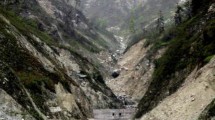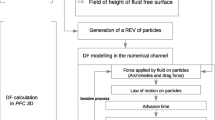Abstract
Debris flows are rapid gravity-driven unsteady flows of highly concentrated mixtures of water and solid particle material, destroying numerous mountain building structures and traffic facilities. The investigation of debris flows is thus of significance to hazard prevention and mitigation. This paper aims to provide a numerical model capable of reproducing debris flow impact estimation by accounting for the complicated fluid-particle-structure interaction (FPSI) using a coupled smoothed particles hydrodynamics (SPH), discrete element method (DEM), and finite element method (FEM) approach. The fluid phase is represented by SPH. The solid phase consists of physical particle(s) and is represented by the DEM, and the deformable structure is represented by the FEM. The interaction forces among the fluid, solid particles, and structure are computed using the penalty function method. The proposed model is capable of simultaneously simulating a fluid-particle interaction (FPI), particle-structure interaction (PSI), and fluid-structure interaction (FSI), with good agreement between the complicated hybrid numerical and experimental results. Finally, a Wenjia gully debris flow is carried out to demonstrate the capability of the coupled model in simulating the FPSI as an application of debris flow impact simulations. When compared with the actual situation, the propagation of the debris flow and destruction of the structures were predicted accurately. Additionally, the Wenjia gully debris flow was treated, and the treatment measure was analyzed from the impact evolution (e.g., interception by dams, impact force, and destruction of dams). The developed method will contribute to a better understanding of the FPSI and is a promising tool for hazard analysis and mitigation.





















Similar content being viewed by others
References
Albaba A, Lambert S, Kneib F, Chareyre B, Nicot F (2017) DEM modeling of a flexible barrier impacted by a dry granular flow. Rock Mech Rock Eng 50:3029–3048
Bithell M, Richards KS, Bithell EG (2015) Simulation of scree slope dynamics: investigating the distribution of debris avalanche events in an idealised two dimensional model. Earth Surf Process Landf 39:1601–1610
Cascini L, Cuomo S, Pastor M, Sorbino G, Piciullo L (2014) SPH run-out modelling of channelised landslides of the flow type. Geomorphology 214(2):502–513
Chen HX, Li J, Feng SJ et al (2019) Simulation of interactions between debris flow and check dams on three-dimensional terrain. Eng Geol 251:48–62
Cheung AKC, Yiu J, Lam HWK, Sze EHY (2018) Advanced numerical analysis of landslide debris mobility and barrier interaction. HKIE Transaction 25(2):76–89
Cleary PW (2015) Prediction of coupled particle and fluid flows using DEM and SPH. Miner Eng 73:85–99
Dai Z, Huang Y, Cheng H, Xu Q (2016) SPH model for fluid-structure interaction and its application to debris flow impact estimation. Landslides 14(3):1–12
Darve F, Xingyue L, Jidong Z (2018) A Unified CFD-DEM Approach for Modeling of Debris Flow Impacts on Flexible Barriers. Int J Numer Anal Methods Geomech 42:1643–1670
DZ-T0239-2004 (2004) Design specification of debris flow disaster prevention project
Escallón JP, Wendeler C, Chatzi E, Bartelt P (2014) Parameter identification of rockfall protection barrier components through an inverse formulation. Eng Struct 77:1–16
Feng SJ, Gao HY, Gao L, Zhang LM, Chen HX (2019) Numerical modeling of interactions between a flow slide and buildings considering the destruction process. Landslides 16(10):1903–1919
Gomez-Gesteira M, Dalrymple RA (2004) Using a three-dimensional smoothed particle hydrodynamics method for wave impact on a tall structure. J Waterw Port Coast 130(2):63–69
Hallquist JO (2017) LS-DYNA theory manual. Livermore Software Technology Corporation (LSTC), Livermore
He S, Liu W, Li X (2016) Prediction of impact force of debris flows based on distribution and size of particles. Environ Earth Sci 75(4):298
Hu W, Xu Q, Rui C et al (2015) An instrumented flume to investigate the initiation mechanism of the post-earthquake huge debris flow in the southwest of China. Bull Eng Geol Environ 74(2):393–404
Huang HQ (2010) Preliminary study on the mechanism and kinematics characteristics of rockslides (Sturzstrom) triggereed by earthquake–taking the Wenjiagou Rockslide-Sturzstrom as An example. Dissertation, Chengdu University of Technology (In Chinese)
Huang Y, Cheng HL, Dai ZL et al (2015) SPH-based numerical simulation of catastrophic debris flows after the 2008 Wenchuan earthquake. Bull Eng Geol Environ 74(4):1137–1151
Hungr O, Morgan GC, Kellerhals R (1984) Quantitative analysis of debris torrent hazard for design of remedial measures. Can Geotech J 21(4):663–677
Jensen A, Fraser K, Laird G (2014) Improving the precision of discrete element simulations through calibration models. In: 13th International LS-DYNA users conference. pp 1-12
Jiang YJ, Towhata I (2013) Experimental study of dry granular flow and impact behavior against a rigid retaining wall. Rock Mech Rock Eng 46(4):713–729
Karajan N, Han Z, Teng H, Wang J (2014) On the parameter estimation for the discrete-element method in LS-DYNA®. In: 13th International LS-DYNA users conference. pp 1-9
Kwan JSH, Sze EHY, Carlos L (2019) Finite element analysis for rockfall and debris flow mitigation works. Can Geotech J 56(9):1225–1250
Law RPH, Kwan JSH, Ko FWY et al. (2018) Three dimensional debris mobility modelling coupling smoothed particles hydrodynamics and ArcGIS. In: 19th International Conference on Soil Mechanics and Geotechnical Engineering. pp 3501-3504
Leonardi A, Wittel FK, Mendoza M, Vetter R, Herrmann HJ (2016) Particle-fluid-structure interaction for debris flow impact on flexible barriers. Comput Aided Civ Infrastruct Eng 31(5):323–333
Li JJ, Wang XL, Zhu YP et al (2015) Experimental study on dynamic response of debris flow dam with braces under impact loads. J Vib Shock 34(18):79–86 (In Chinese)
Liu C, Yu ZX, Luo LR et al (2019) Dynamic behavior of a concrete dam impacted by debris flows with rock. J Vib Shock 38(14):161–169 (In Chinese)
Liu C, Yu ZX, Zhao SC (2020a) Quantifying the impact of a debris avalanche against a flexible barrier by coupled DEM-FEM analyses. Landslides 17:33–47
Liu C, Yu ZX, Zhao SC (2020b) Consideration of maximum impact force design for a rock shed against dry granular flow. Eur J Environ Civ Eng 9:1–22
Luo HY, Zhang LL, Zhang LM (2019) Progressive failure of buildings under landslide impact. Landslides 16(7):1327–1340
Ni HY, Zheng WM, Tie YB et al (2012) Formation and characteristics of post-earthquake debris flow: a case study from Wenjia gully in Mianzhu, Sichuan, SW China. Nat Hazards 6:317–335
Rickenmann D (1999) Empirical relationships for debris flows. Nat Hazards 19(1):47–77
Rickenmann D, Laigle D, McArdell BW, Hübl J (2006) Comparison of 2D debris-flow simulation models with field events. Comput Geosci 10(2):241–264
Shen W, Tao Z, Zhao J et al (2018) Quantifying the impact of dry debris flow against a rigid barrier by DEM analyses. Eng Geol 241:86–96
Shieh CL, Ting CH, Pan HW (2008) Impulsive force of debris flow on a curved dam. Int J Sediment Res 23(2):149–158
Song D, Choi CE, Zhou GGD, Kwan JSH, Sze HY (2018) Impulse load characteristics of bouldery debris flow impact. Geotech Lett 8(2):111–117
Su J, Zhou C, Chen SS et al (2015) Numerical simulation of flexible gabion arch dam to prevent and control debris flow blocks. Chin J Geotech Eng 37(2):269–275 (In Chinese)
Sun X, Sakai M, Yamada Y (2013) Three-dimensional simulation of a solid-liquid flow by the DEM-SPH method. J Comput Phys 248:147–176
Tang C, Van Asch TWJ, Chang M et al (2010) Catastrophic debris flows on 13 August 2010 in the Qingping area, southwestern China. Geomorphology 139:559–576
Vetter R, Stoop N, Jenni T, Wittel F, Herrmann H (2013) Subdivision shell elements with anisotropic growth. Int J Numer Methods Eng 95(9):791–810
Wang W, Chen G, Han Z et al (2016) 3D numerical simulation of debris-flow motion using SPH method incorporating non-Newtonian fluid behavior. Nat Hazards 81(3):1981–1998
Wang DP, Chen ZP, He SM et al (2019) Physical model experiments of dynamic interaction between debris flow and bridge pier model. Rock Soil Mech 40(9):3363–3372 (In Chinese)
Wendeler C, Volkwein A, Mcardell BW, Bartelt P (2019) Load model for designing flexible steel barriers for debris flow mitigation. Can Geotech J 56(6):893–910
Wu K, Yang D, Wright N, Khan A (2018) An integrated particle model for fluid-particle-structure interaction problems with free-surface flow and structural failure. J Fluid Struct 76:166–184
Xie T, Yang H, Wei F et al (2014) A new water-sediment separation structure for debris flow defense and its model test. Bull Eng Geol Environ 73(4):947–958
Xu JX, Wang Jason (2014) Interaction Methods for the SPH Parts (Multiphase Flows, Solid Bodies) in LS-DYNA®. In: 13th International LS-DYNA users conference. pp 1–12
Xu Q, Zhang S, Li WL, Van Asch TW (2012) The 13 August 2010 catastrophic debris flows after the 2008 Wenchuan earthquake, China. Nat Hazards Earth Syst Sci 12(1):201–216
Yu B, Ma Y, Wu Y (2013) Case study of a giant debris flow in the Wenjia Gully, Sichuan Province, China. Nat Hazards 65(1):835–849
Zhang J, Guo ZX, Cao SY, Singh VP (2013) Scale model for the confluent area of debris flow and main river: A case study of the Wenjia Gully. Nat Hazards Earth Syst Sci 13(12):3083–3093
Zhang H, Tan Y, Shu S et al (2014) Numerical investigation on the role of discrete element method in combined LBM-IBM-DEM modeling. Comput Fluids 94:37–48
Funding
The work in this study was supported by the National Key R&D Program of China under Grant No. 2018YFC1505405, the Natural Science Foundation of China under Grant No. 51678504, the National Key Research and Development Program of China under Grant No. 2016YFC0802205, the Department of Science and Technology of Sichuan Province under Grant No. 2018JY0029, the Science and Technology Research and Development Program of China Railway Corporation under Grant No. 2018KY10, the Shock and Vibration of Engineering Material and Structure Key Laboratory of Sichuan Province under Grant No. 18kfgk07 and the Fundamental Research Funds for the Central Universities under Grant No. 2682019ZT04.
Author information
Authors and Affiliations
Corresponding author
Rights and permissions
About this article
Cite this article
Liu, C., Yu, Z. & Zhao, S. A coupled SPH-DEM-FEM model for fluid-particle-structure interaction and a case study of Wenjia gully debris flow impact estimation. Landslides 18, 2403–2425 (2021). https://doi.org/10.1007/s10346-021-01640-6
Received:
Accepted:
Published:
Issue Date:
DOI: https://doi.org/10.1007/s10346-021-01640-6




